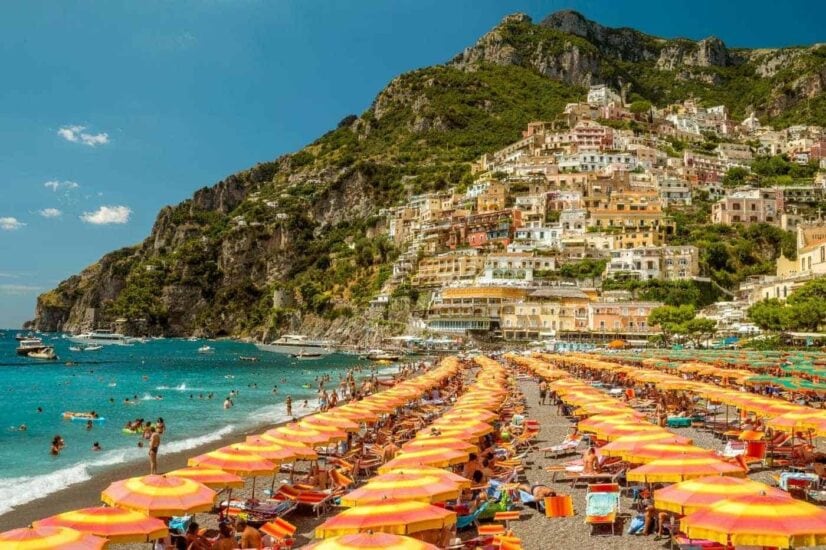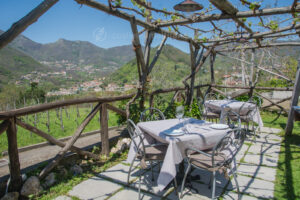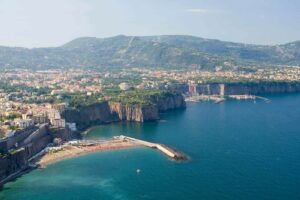The beaches of the Amalfi Coast are among the most beautiful in the Tyrrhenian Sea and the world, even if they are not very extensive.
“The beauty of things loves to hide itself” and here, amidst impervious cliffs and portions of rock that are majestically mirrored in the crystal-clear waters, one can find small portions of fine white or pebbly beach, a source of tourist attraction.
Forget the classic, immense Caribbean beaches and get ready to discover a new, slightly more strenuous way of experiencing the sea.
The towns on the Amalfi Coast are above sea level and one often has to cross paths or descend some steps carved into the rock to reach the sea.
The sun peeps out in the early afternoon, so after a hearty breakfast, let yourself be carried away by the call of the waves, whose sound evokes the song of the Sirens.
Indice dei contenuti
The easiest beaches on the Amalfi Coast to reach: Amalfi and Atrani
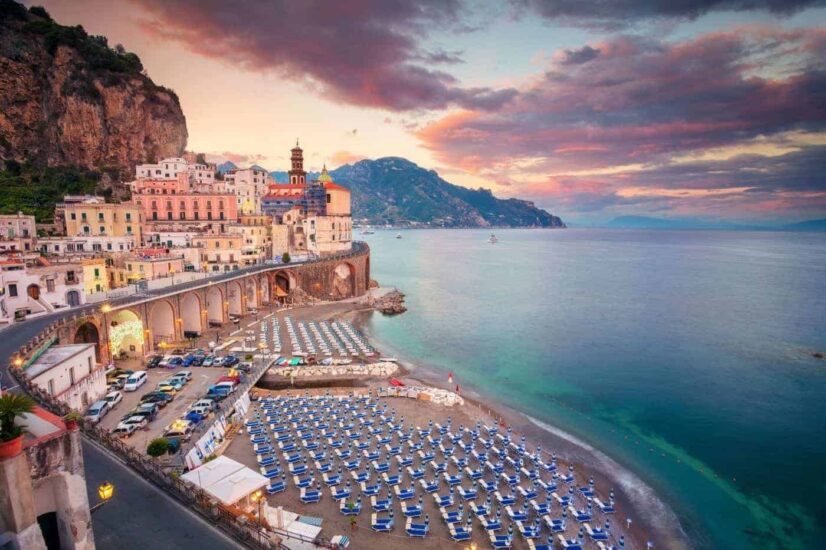
We begin our journey to discover the most beautiful beaches on the Amalfi Coast starting with those between Amalfi and Atrani, which cater for all types of tourists: those looking for a corner of paradise away from the chaos and those who prefer equipped beaches, with the latest hit in the background and the laughter of the beach umbrella neighbours.
The Marina Grande beach in Amalfi is quite lively and suitable for those who want to experience a sparkling summer: the place is one of the centres of coastal nightlife in the summer. Sports enthusiasts are also catered for: to get to Duoglio beach, 1 km from Amalfi, you have to descend 400 steps at km 28 of the state road, at the bottom of which is the ‘Lido degli artisti’ (artists’ lido) where you can rent equipment for water sports such as canoeing, windsurfing and diving.
The ‘Due scugnizzi’ lido is much quieter and there is a small restaurant offering typical fresh fish dishes. Every day from 09.00 to 17.00, every 30 minutes, boats depart from the Amalfi pier to take you to hidden beaches inaccessible by land such as Santa Croce: the return ticket costs 4.50 euro.
The public car park in Piazza Flavio Gioia in Amalfi, is very spacious, 60 minutes parking costs 5 euro, if you leave at the crack of dawn you can park on the few white lines in the area. Atrani beach is a favourite with families with small children in tow and is one of the most characteristic of the coast because it is divided in two by the mouth of the Dragone, which runs dry during the summer months.
Before arriving in Amalfi, on the SS 163 there is a diversion that marks the village. In summer, access to the beach is forbidden to non-residents and the entrance is blocked with a bar. The public car park can only accommodate 30 cars and is busy from the morning, so the only solution is to leave your car in Amalfi, which is connected to Atrani by a scenic route.
Ravello’s hidden beach
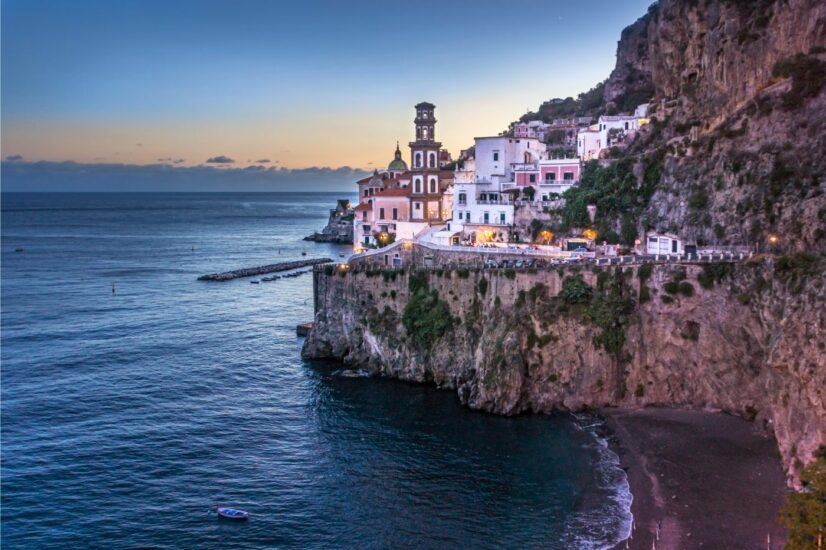
Continuing along the SS163 we find the Castiglione beach in Ravello, little known and therefore a niche destination. The historic centre of this village perched on the hill ‘hides’ the seaside hamlet that has a beach surrounded by cliffs where a bathing establishment is located.
Unfortunately, on the Amalfi Coast there are only a limited number of areas with free access, here in Castiglione on both sides you can enjoy a wild experience in the shade of the Mediterranean maquis.
To access it, you have to walk up the steps on the state road, just before the junction for Ravello. If you arrive by car, park in Atrani or Ravello and walk towards the panoramic paths. Our advice is to take advantage of public transport, the SITA line makes several stops in front of the steps leading to the beaches.
Cetara and its quiet beaches
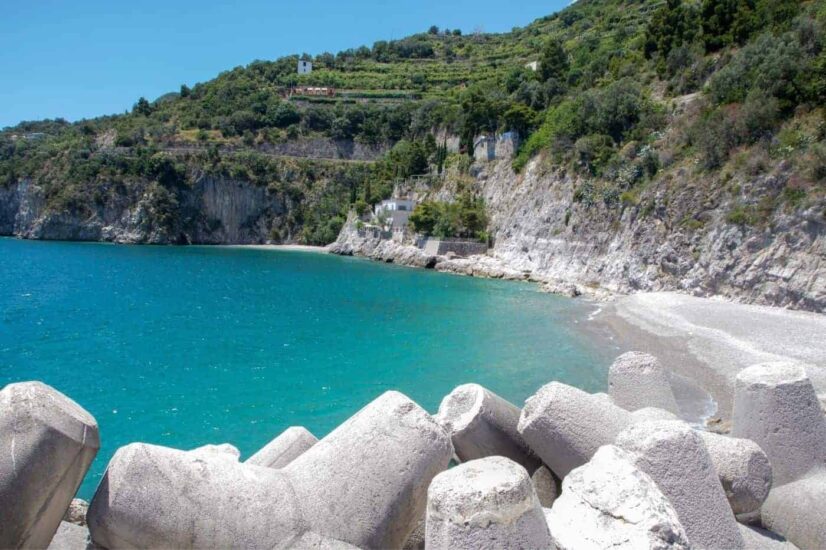
When you say Cetara, the famous Colatura di Alici immediately springs to mind.
The village’s small beach was formed after the earthquake in the 1980s and has a bathing establishment with all the services, even a restaurant where you can enjoy typical fish dishes between one swim and the next.
Despite being an extension of the village, the seabed is clean and until late afternoon the sun accompanies tourists in search of the perfect tan. In the beginning it was a deposit of building materials, but the sea decided to take it back and transported sand and pebbles in abundance.
To access it, leave your car in the public pay car park and drive through the gap behind the harbour. Lannio beach is a short walk from the centre of Cetara, interestingly named after the ‘lagne’, or laments of the monks executed by the Saracens during their numerous incursions.
It is hidden behind the harbour tower with its inevitable staircase.
Cetara is a town mostly famous due to its “colatura”, a very tasty sauce prepared from anchovies. Even though you may want to visit the city mainly for its culinary mastery, it is also worth to pay a visit to the local beach.
The small beach hosts a small resort and also a restaurant, where you will be able to try the local specialties between some swimming and some rest under the sun.
From the center of Cetara, walking for a few minutes, you can also reach Lannio beach, a historical beach where in the past some monks were executed by Arab Pirates. Where the beauty meets history, even though in this particular portion of the Amalfi Coast it gets a bit macabre!
Explore the beauty of the sea! Experience thrilling adventures along the Amalfi Coast.
Maiori and Minori: the Amalfi Coast bathing style
Maiori’s beach represents a decidedly unusual panorama compared to what is offered by the Amalfi Coast: a kilometre of sandy beach and no less than 15 bathing establishments lined up along the flat seafront that was developed after the catastrophic natural event of 1954 and now houses hotels and restaurants. At the ends are two stretches of free beach with unobtrusive little kiosks.
The bathing establishments offer the possibility of booking jet skis and pedal boats, or of being taken on a discovery tour of the Pandora Cave and the Sulphurous Cave. Parking in this area is not a problem; towards the end of the straight stretch along the sea, on the right, there is a pay car park.
Obviously, however, during peak periods it can be particularly difficult to park and one has to turn to private operators who have various spaces in the village. Close to Maiori is Erchie, with 200 metres of beach that are marked by the presence of the Saracen towers.
The hamlet is rather small and parking, in the busiest months, can be quite complicated. While Maiori has changed its appearance, Minori has remained the same, with its narrow streets plunging into the azure blue of the Tyrrhenian Sea, but on closer inspection, there is some way to go before plunging into the sea.
The 250-metre beach has three bathing establishments and its position, which faces south, allows it to be sun-kissed all day long. To reach it you have to go past Maiori and round a few bends. Being smaller, there is less parking.
The beaches of Positano, beautiful not only on postcards!
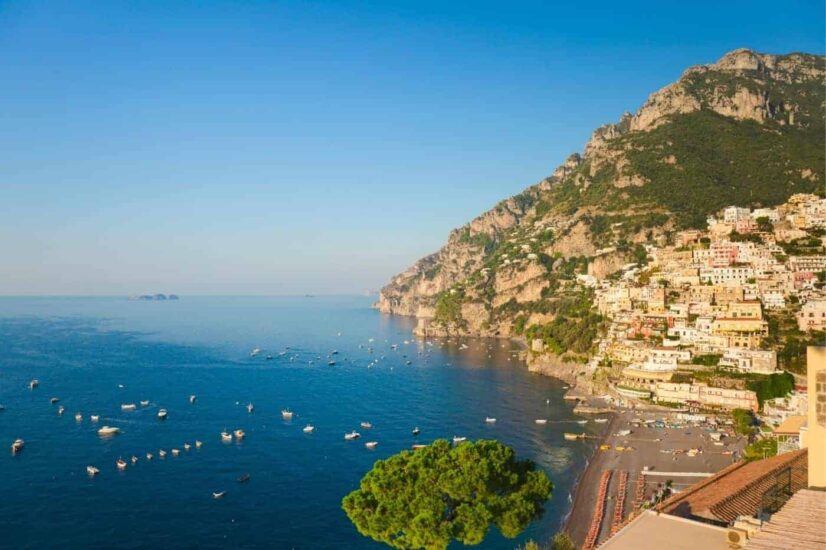
Positano offers a sea of opportunities from Laurito to Fornillo. A destination coveted by the international jet set, it fascinates foreign and Italian tourists in search of a salty holiday.
Laurito beach takes its name from the laurel bushes that grow wild in the area and accompany the flight of steps. The atmosphere here is one of tranquillity due to the few free areas; most are managed by hotels and the customers are rather reserved.
The beach at Arienzo, on the other hand, well known for its 300 steps set in a fairy-tale landscape among the most luxurious villas, faces south-west and the sun stays here until late. To reach these two beaches by car, after passing through the centre of Positano, drive towards Amalfi. From Hotel San Pietro, the steps to Laurito start, and 800 metres later, those to Arienzo. The two resorts are connected by a straight line with car parks.
Positano’s main beach is Marina Grande, its 300-metre sandy shore is surrounded by the colourful houses of the centre and overlooks the Li Galli islands. There are bathing establishments, restaurants and clubs where you can hang out from sunset to sunrise. In the free area is the embarkation point for the nearby coves accessible only by sea. The dark sand and pebbles do not deter tourists who want to spend a holiday of a certain standard.
Fornillo, which can be reached from the boat jetty via a romantic footpath, is also very interesting. Both beaches can be reached by walking downhill from the state road where pay car parks are located.
Discover the magic of the sea! Book now for extraordinary experiences
The Nordic charm of the Fjord of Furore

The Fiordo di Furore is just a stone’s throw from Praiano.
It is overlooked by a bridge from which one can glimpse the small strip of fairly deep beach in front of the fishing village, now a museum and uninhabited. At km 23 of the SS 163 there are steps leading to the beach.
Unfortunately, there is no parking along the state road, which is rather narrow at this point, but by parking in the centre of Praiano, you can get there by shuttle bus or public transport. Nearby is the beach of Marina di Praia, part of the Praiano municipality and famous for its pebbles and Torre a Mare towering above it.
The lido is equipped with bars, restaurants and sunbeds, and those who want to go as far as Grotta dell’Africana, Grotta Suppraiano and Cala di Gavitella can do so aboard one of the pretty boats that set sail every half hour.
We would like to remind our travellers that Cala della Gavitella has a splendid view of Positano and Capri and that it can also be reached on foot, tackling 413 steps.
Vietri sul Mare: towards infinity and beyond

Last but not least, the beach at Vietri sul Mare, gateway to the Amalfi Coast and main junction to nearby Salerno.
The only railway station, reached by regional trains, is located here and is a good compromise if you have left your car at home because you do not intend to pay for parking.
The first beach is La Baia, a good 400 metres long. Unfortunately, the waters are not crystal-clear because of the proximity to the port of Salerno, but the bathing establishments offer many services. The beach has a private car park reserved for bathing establishment customers.
The beach at Marina di Vietri, like the one at Maiori, was formed after the 1954 flood that affected part of the Amalfi Coast. Mud and debris came down from the Lattari Mountains and stole space from the sea.
The beach is divided into two parts by the Bonea river, one of which is free and from here you can go to the coves scattered around. Marina di Albori, on the other hand, is a small hamlet inhabited by 350 people and is connected to the sea by small paths that climb up the mountains.
The bathing establishments all have private parking, for the adventurous there is the public one, always for a fee, which opens at 7 a.m. and closes at 8 p.m.

